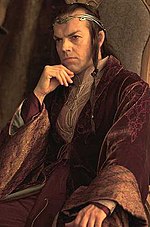
Modern fantasy literature has revived the elves as a race of semi-divine beings of human stature who are friendly with animals. Fantasy elves are different from Norse elves, but are more akin to that older mythology than to folktale elves – they are unlikely to sneak in at night and help a cobbler mend his shoes.
The first appearance of modern fantasy elves occurred in The King of Elfland's Daughter a 1924 novel by Lord Dunsany. The next modern work featuring elves was The Hobbit, a 1937 novel by J. R. R. Tolkien. Elves played a major role in many of Tolkien's later works, notably The Lord of the Rings. Tolkien's elves were followed by grim Norse-style elves of human size in Poul Anderson's 1954 fantasy novel The Broken Sword.
Though Tolkien originally conceived his Elves as more fairy-like than they afterwards became, he also based them on the god-like and human-sized Ljósálfar of Norse mythology. His Elves were conceived as a race of beings similar in appearance to humans but fairer and wiser, with greater spiritual powers, keener senses, and a closer empathy with nature. They are great smiths and fierce warriors on the side of good.
Tolkien's Elves of Middle-earth are immortal in the sense that they are not vulnerable to disease or the effects of old age. Although they can be killed in battle like humans and may alternately wither away from grief, their spirits only pass to the blessed land in the west called Valinor, whereas humans' souls leave the world entirely.
Tolkien's The Lord of the Rings (1954-1955) became astoundingly popular and was much imitated. In the 1960s and afterwards, elves similar to those in Tolkien's novels became staple non-human characters in high fantasy works and in fantasy role-playing games.
Tolkien's Elves were enemies of goblins (orcs) and had a longstanding quarrel with the Dwarves; these motifs often reappear in Tolkien-inspired works.
Tolkien is also responsible for reviving the older and less-used terms elven and elvish rather than Edmund Spenser's invented elfin and elfish. He probably preferred the word elf over fairy because elf is of Anglo-Saxon origin while fairy entered English from French. He certainly felt the need to differentiate elves, as only one kind of the creatures of Faërie, from other inhabitants of that land, and lamented the confusion in English between Fairy (i.e., Faërie) and fairy (i.e., fay or elf). Tolkien also wished to distinguish his elves from the diminutive airy-winged fairies popularized by Drayton’s Nymphidia.[34]
Post-Tolkien fantasy elves (popularized by the Dungeons & Dragons role-playing game) tend to be more beautiful and wiser than humans, with sharper senses and perceptions. Often elves do not possess facial or body hair, and are consequently perceived to be androgynous.
A hallmark of fantasy elves is also their long and pointed ears (a convention begun with a note of Tolkien's that the ears of elves were "leaf-shaped"). The length and shape of these ears varies depending on the artist or medium in question.
Half-elves and divergent races of elves, such as high elves and dark elves, were also popularized at this time; in particular, the evil drow of Dungeons & Dragons have inspired the dark elves of many other works of fantasy.
Fair elves of the Tolkien mold have become standardized staple characters of modern fantasy to such an extent that diverging from the established conceptions of how an elf is supposed to look and behave has become an end in itself for certain works of fantasy which aspire to innovation. For examples of the various ways modern fantasy writers have achieved this, see the main article.
It is worth noting that those things described as being of or related to these fair elves are referred to as "elven", as opposed to "elfish" (a term more closely associated with the sprite-like elves of medieval conception).

No comments:
Post a Comment